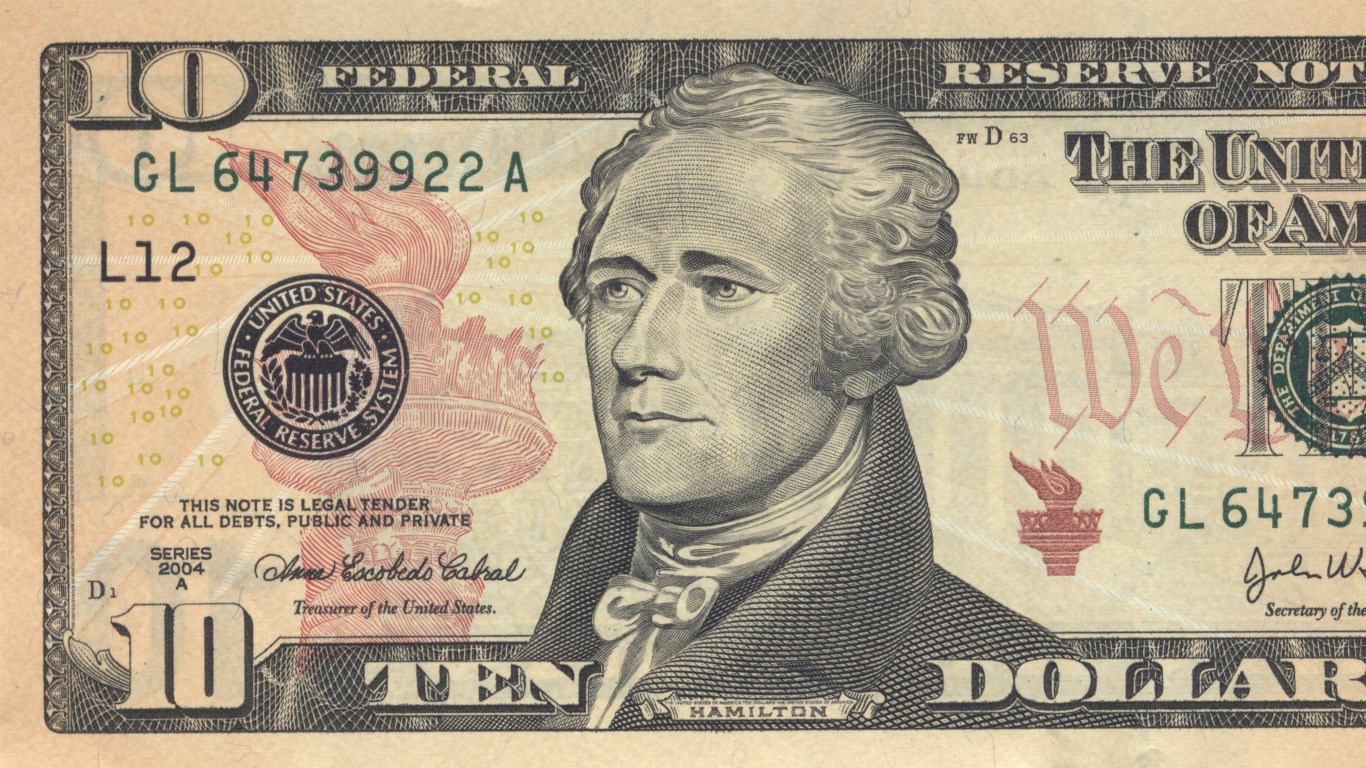
The three major U.S. equity indexes closed mixed on Tuesday. The Dow Jones industrial blue-chippers added about 0.2%, while the S&P 500 closed down 0.8% and the Nasdaq retreated nearly 2.4%. The Federal Reserve releases the minutes of its April meeting Wednesday afternoon, an event that is watched closely for hints about what the U.S. central bank may do next. Equities traded slightly lower in Wednesday’s premarket session.
[in-text-ad]
After markets closed Tuesday afternoon, Intuit reported results, beating estimates for both the top and bottom lines. Shares traded up about 2.8% in the premarket.
Nordstrom missed earnings per share (EPS) expectations but beat the revenue estimate and issued upside guidance for the 2023 fiscal year. The stock was up more than 9% Wednesday morning.
Toll Brothers also beat top-line and bottom-line estimates but noted that, while demand is solid for now, it is not equal to the runup of the past two years because home buyers are reacting to higher interest rates and macroeconomic conditions. The stock traded up 3.6%.
Grindrod Shipping reported better than expected results on both the top and bottom lines. Shares traded down about 4.5% in Wednesday’s premarket session.
Star Bulk Carriers also reported beats to earnings and revenue estimates. Shares traded higher by about 3.4% Wednesday morning.
Dick’s Sporting Goods beat top-line and bottom-line estimates but gave downside guidance well below analysts’ estimates for full-year EPS. Shares traded down more than 12% in Wednesday’s premarket.
After Wednesday’s closing bell, results are due from Nvidia, Snowflake and Splunk. Thursday morning has earnings on tap from Alibaba, Baidu, Dollar Tree and Macy’s.
Here is a look at five firms set to report earnings late Thursday or early Friday.
Big Lots
Discount retailer Big Lots Inc. (NYSE: BIG) has had a share price decline of 58% over the past 12 months. The stock’s 52-week high was posted in early June and shares have been sliding ever since. Rising inflation and a challenging macroeconomic environment have made the past year a dismal one for investors. In March, an activist investor called for the company to do a sale-and-leaseback deal and take fuller advantage of its borrowing power. Big Lots reports results before markets open on Friday.
Analyst sentiment is mixed on Big Lots, with five of 10 brokerages having a Hold rating while just one rates the stock at Buy. At a recent share price of around $26.20, the stock’s upside potential based on a median price target of $33.00 is 25.8%. At the high target of $47.00, the upside potential is 79.4%.
[in-text-ad]
Fiscal 2023 first-quarter revenue is forecast at $1.46 billion, which would be down 15.8% sequentially and 10.4% lower year over year. Analysts are forecasting adjusted EPS of $1.00 for the quarter, down 42.9% sequentially and 61.8% year over year. For the full fiscal year ending in January, the consensus estimates call for EPS of $4.52, down 16.9%, on sales of $6.12 billion, down 0.5%.
The company’s stock trades at 5.8 times expected 2023 EPS, 4.9 times estimated 2024 earnings of $5.32 and 4.6 times estimated 2025 earnings of $5.76 per share. The stock’s 52-week trading range is $24.87 to $73.23. Big Lots pays an annual dividend of $1.20 (yield of 4.57%), and the total shareholder return for the past year was negative 57.5%.
Canopy Growth
Marijuana grower and cannabis products maker Canopy Growth Corp. (NASDAQ: CGC) has seen its share price drop by more than 79% over the past 12 months. The company’s market cap has decreased from about $3.2 billion three months ago to $2.02 billion as of Tuesday night’s close. The cannabis industry has been waiting for more action from the U.S. Congress to decriminalize cannabis-based products, but it has not happened yet. Until it does, all Canopy Growth and its peers can do is try to hold on. The company reports results before markets open on Friday.
Analysts continue to take a moderately negative view on the stock. Of 21 brokerages covering the shares, 10 have a Hold rating and nine have a Sell or Strong Sell rating. Only two have a Buy rating. At a share price of around $4.75 and a median price target of $6.92, the upside potential is 45.7%. At the high price target of $19.74, the upside potential is more than 315%.
Analysts estimate that Canopy Growth’s fourth-quarter revenue for fiscal 2022 will come in at $109.87 million, down 8.8% sequentially but up 35.1% year over year. The consensus estimate calls for an adjusted loss per share of $0.16, slightly worse than an adjusted loss of $0.13 in the prior quarter but better than the year-ago loss of $1.28 per share. For the full fiscal year ended in March, analysts expect a loss of $0.07 per share, significantly better than last year’s loss of $2.51 per share. Full-year revenue is forecast at $424.54 million, down about 12.1%.
Canopy Growth is not expected to post a profit in 2022, 2023 or 2024. The company’s sales to enterprise value multiple for 2022 is 5.0, 4.5 for 2023 and 3.9 for 2024. The stock’s 52-week range is $4.70 to $26.96, and the low was posted Tuesday. Canopy Growth does not pay a dividend, and the total shareholder return for the past year is negative 79%.
Costco
Shares of Costco Wholesale Corp. (NASDAQ: COST) have added about 15.7% over the past 12 months, including a drop of nearly 28% since early April. Judging by the stock’s sharp fall over the past week or so, investors expect Costco to follow the down staircase along with Walmart and Target.
[in-text-ad]
Costco’s profit has always been a function of its membership model and the revenue the company derives from those paying customers. Will consumers continue to pay for the privilege of saving money by buying Costco’s bulk packages of light bulbs and oatmeal? We shall find out when the company reports quarterly results after Thursday’s close.
Analysts are positive on the stock, with 23 of 34 having a Buy or Strong Buy rating. Another 10 rate the stock at Hold. At a share price of around $437.70, the upside based on a median price target of $587.00 is 34.1%. At the high price target of $678.00, the upside potential is 54.9%.
Third-quarter revenue is forecast at $51.45 billion, down about 0.9% sequentially and up 16.5% year over year. Adjusted EPS are forecast at $3.02, up 3.6% sequentially and 9.8% year over year. For the full 2022 fiscal year ending in August, current estimates call for EPS of $13.08, up 18.1%, on sales of $222.97 billion, up 13.8%.
Costco stock trades at 33.5 times expected 2022 EPS, 30.6 times estimated 2023 earnings of $14.30 and 27.7 times estimated 2024 earnings of $15.81 per share. The stock’s 52-week range is $375.50 to $612.27. The company pays an annual dividend of $3.16 (yield of 0.72%). Total shareholder return for the past year was about 14.9%.
Farfetch
London-based Farfetch Ltd. (NYSE: FTCH) operates an e-commerce marketplace for luxury fashion goods in the United States, the United Kingdom and elsewhere. Unusually, the company’s focus on luxury products does not seem to be helping it out during this period of high inflation and consumer caution. The stock’s value has dropped by 83% over the past 12 months.
When the company reports quarterly results after markets close Thursday, investors will be looking for signs that it can replace its Russian business, which accounted for about 6% of its volume, and get its European market back in a buying mode.
Analysts are quite bullish on the stock, with 15 of 20 having a Buy or Strong Buy rating. The other five rate the stock at Hold. At a share price of around $6.80, the upside based on a median price target of $28.00 is about 312%. At the high price target of $56.00, the upside potential is 768%. Some adjustments may be due.
Farfetch’s revenue for the first quarter of fiscal 2023 is forecast at $561.86 million, down about 15.6% sequentially and up 15.8% year over year. Analysts are expecting an adjusted loss per share of $0.21, far worse than the prior quarter’s loss of $0.03, and a penny better than the loss in the year-ago quarter. For the full fiscal year, current estimates call for an adjusted loss per share of $0.64, compared to last year’s loss of $0.55 per share, on sales of $2.76 billion, up 22.2%.
[in-text-ad]
Farfetch is not expected to post a profit in 2023 or 2024. The stock trades at a multiple of 19.5 times expected 2025 earnings of $0.35 per share. The stock’s 52-week range is $6.53 to $53.77, and the low was posted Tuesday. The company does not pay a dividend, and the total shareholder return for the past year was negative 83.5%.
Gap
Apparel retailer Gap Inc. (NYSE: GPS) has seen its share price plummet by about 70% over the past 12 months. Since reaching a peak in mid-May last year, the stock has been on a steady downward path. Some analysts believe the company’s stock has reached a bottom and that a turnaround is due. But inflation, rising costs and supply chain issues militate against that. Investors and analysts will be paying close attention to what executives have to say on the conference call. Gap reports results after markets close Thursday.
Analysts continue to be cautious on the stock, with 14 of 22 having a Hold rating and just four others rating the stock at Buy. At a share price of around $9.50, the implied upside based on a median price target of $14.00 is 47.4%. At the high target of $28.00, the implied gain is almost 195%.
First-quarter fiscal 2023 revenue is forecast to come in at $3.49 billion, down 22.9% sequentially and 12.5% lower year over year. Analysts are forecasting an adjusted loss per share of $0.13, compared to a prior quarter loss of $0.02 per share and EPS of $0.48 in the year-ago quarter. For the full fiscal year that ends next January, analysts currently expect EPS of $1.41, down 2.2%, on sales of $16.25 billion, down 2.5%.
Gap stock trades at 6.7 times expected 2023 EPS, 5.5 times estimated 2024 earnings of $1.73 and 5.0 times estimated 2025 earnings of $1.90 per share. The stock’s 52-week range is $9.24 to $35.35, and the low was posted Tuesday. Gap pays an annual dividend of $0.60 (yield of 5.8%), and the total shareholder return for the past year was negative 70.4%. How long can that dividend yield last?
100 Million Americans Are Missing This Crucial Retirement Tool
The thought of burdening your family with a financial disaster is most Americans’ nightmare. However, recent studies show that over 100 million Americans still don’t have proper life insurance in the event they pass away.
Life insurance can bring peace of mind – ensuring your loved ones are safeguarded against unforeseen expenses and debts. With premiums often lower than expected and a variety of plans tailored to different life stages and health conditions, securing a policy is more accessible than ever.
A quick, no-obligation quote can provide valuable insight into what’s available and what might best suit your family’s needs. Life insurance is a simple step you can take today to help secure peace of mind for your loved ones tomorrow.
Click here to learn how to get a quote in just a few minutes.
Thank you for reading! Have some feedback for us?
Contact the 24/7 Wall St. editorial team.

 24/7 Wall St.
24/7 Wall St. 24/7 Wall St.
24/7 Wall St. 24/7 Wall St.
24/7 Wall St. 24/7 Wall St.
24/7 Wall St.



